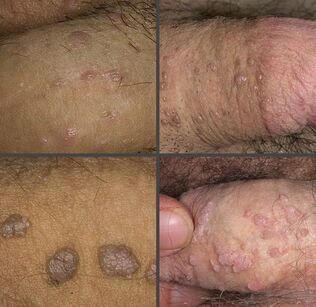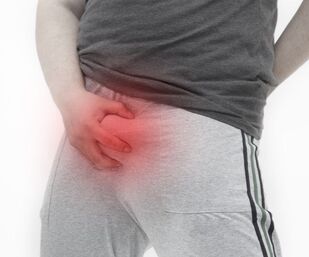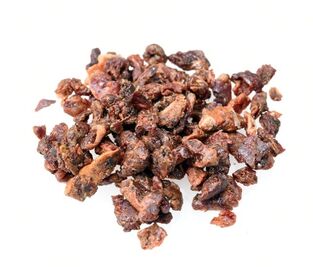Penile warts are small plants located in the foreskin, sternum, head of the penis, or stalk. They are also called genital warts. This provokes the pathology of certain strains of papillomavirus, which is prone to recurrent manifestations and is never completely eliminated from the body.
Causes of male wart penis formation

Warts are viral growths caused by the human papillomavirus. HPV is a large group of pathogenic microorganisms. About 100 strains of this pathogen were studied. In addition, these viruses are divided into different categories according to the level of oncogenicity.
It is estimated that about 90% of the world's population is infected with one type of papilloma virus or another. Pathogens in the external environment live very little and die quickly. It is most commonly transmitted through sexual intercourse, less frequently in daily life, or from mother to child. Viral agents are localized in the surface layer of the mucosa and epidermis.
As for male penile warts, they are caused by strains 6 and 11. These viruses are responsible for genital warts. These are relatively non-oncogenic types that can quite rarely cause malignant tumors.
In order for the virus to enter the body, it is necessary to contact the infected skin or mucous membranes directly with healthy skin. This usually happens during unprotected sex. The risk of infection increases if there are microtraumas on the body surface - scratches, cracks, scratches. The virus penetrates these lesions particularly easily and quickly.
HPV multiplies in deep layers of skin in human epidermal cells. As the disease progresses, epithelial cells move upward along with viral agents. Thus, the papillomavirus reaches the surface of the skin and provokes rapid chaotic growth of epidermal cells. This causes warts on the penis.
A distinctive feature of the papillomavirus is that it can remain inactive for a long time in the deep layers of the dermis. Various factors can provoke his progress. For example, weakened immune system, hypothermia, antibiotic use, stress, fatigue, malnutrition, vitamin deficiency, hormonal imbalances, and so on.
However, even when the virus is latent, a person is potentially dangerous in terms of HPV transmission to partners. Knowing the causes of penile warts, we can conclude that these formations can occur in both recent adolescents and the elderly.
Symptoms and types of penis

In most patients, male warts do not usually appear on the penis. They usually occur in places that are prone to injury during sexual intercourse. Therefore, neoplasms can be found on the head, frenulum, foreskin. They occur less frequently on the trunk of the penis and scrotum, the testicles.
Penis warts usually look like small pink, sandy, whitish growths of 2-30 mm. They can be solitary or wandering into groups that form neoplasms similar to the cork stopper.
In the active growth phase, when the immune system is not working, warts on the penis can cause itching, burning in the affected area. In addition, neoplasms are sometimes palpated during intercourse. In the normal state, these growths are painless and do not cause significant discomfort.
Often, warts do not affect a limited area of the genitals, but large areas. Therefore, often warts on the head of the penis gradually spread in the groin area, affecting the anus.
The types of penis warts depend on the strain of the virus infected by the man and their location.
Consider their main types:
- In the foreskin area, neoplasms appear a lighter shade than skin tuberculosis. Sometimes they have a thin leg. Initially, single warts appear, and groups of genital warts can form over time.
- Frenume warts look like small, whitish nodules with a chaotic layout.
- The warts on the head of the penis look like light pink, finger-like growths. They usually form groups similar to broccoli inflorescences.
- Giant Buschke-Levenschein tumors can sometimes form on the axis of the penis. These are some warts that have grown together. It is a rare but dangerous pathology characterized by malignant transformation because neoplasmic cells are prone to rapid mutation.
If suspicious growths are found on the penis, the man should contact a specialist immediately. The urologist examines and interviews the patient. In addition to the penis, the urologist must examine the scrotum, perianal area, and groin. Visual examination is usually sufficient to establish a diagnosis. In some cases, the doctor may refer the man for additional tests.
To determine the pathogen strain and the risk of oncogenicity, the patient must donate blood for PCR testing. Also, if the frenum is damaged, a meatoscopy procedure may be needed to detect the presence of warts in the urethra.
It should be remembered that warts on the head and scrotum of the penis may look like a different type of neoplasm. For example, second-onset syphilis papulosis is also characterized by the development of small tumors. In order to exclude other sexually transmitted diseases, it is also necessary to be tested for common sexually transmitted infections - syphilis, HIV, chlamydia, trichomoniasis, etc.
Danger of male warts on the penis

Initially, penile warts are an aesthetic defect, not a serious pathology that threatens a man’s health. However, this does not mean that they do not need treatment. If you allow the disease to occur, it can cause more serious problems in the future.
The danger of these neoplasms is as follows:
- Development of phimosis.In this condition, the foreskin merges with the head of the penis. This can lead to problems with normal sperm secretion, pathogens accumulating in the space under the foreskin, and inflammatory processes can occur.
- Inflammation of the head, penile trunk.This pathology is a complication of this condition, where bacteria penetrate under the foreskin and spread further.
- Genital erosion.They usually develop as a result of systemic trauma to the penis warts. This happens during sex, shaving, wearing tight underwear.
- Degeneration of neoplasms into cancerous tumors. This is rare, but there is a potential risk, especially if penile warts are often damaged.
Also keep in mind that active neoplasms are dangerous to infect partners. Also, even condoms may not always protect a person from infection.
Methods of treating penile warts
Because the appearance of warts on the penis is directly associated with a general decrease in immunity, treatment of this pathology should be complex and combined. Basically, depending on the neoplasm, various methods of destruction are used. Medications are used to boost immunity and suppress the virus.
Ways to remove warts from the penis

Instrumental and chemical methods are used to remove warts on the penis. It is worth remembering that these growths are in themselves extremely rare and will need to be removed if a man seeks to reduce the risk of complications.
There are several ways to get rid of warts on the penis:
- Laser destruction.The laser beam evaporates from the accumulation, dries, covers the crust and falls off after a few days. There are usually no traces left at the treatment site. The procedure is painless, rarely causing relapses and complications.
- Cryo Removal.Liquid nitrogen, which has a low temperature, points to the neoplasm and leads to its freezing and subsequent death. After treatment, a crust is formed at the site of accumulation, which also disappears after a few days along with the rest of the formation.
- Radiosurgical removal.The neoplasm is affected by radio waves that destroy growth tissue. This is one of the most accurate, effective and safest ways to remove warts from the penis. When the radio waves are removed, no marks remain on the skin.
- Electrocoagulation.At a certain frequency, a current is applied to the electrode, which destroys the formation. This procedure of removing warts from the penis can cause burns and subsequent scarring. Therefore, it is administered with caution.
- Surgical excision.If the penis warts are too large, a scalpel technique may be used in extreme cases. However, they rarely resort to such surgery because of the risk of serious bleeding and the spread of infection. Also, complete circular foreskin excision is indicated for major wart lesions.
Your doctor may also prescribe a chemical removal. The procedure is performed using cauterizing medications.
Before treating penile warts with the help of chemicals, it is necessary to consult a doctor, because these funds have many contraindications, and their improper use poses a risk of complications.
Penis Wart Medications
To eliminate the risk of recurrence of warts on the head of the penis or other parts of the genitals, it is necessary to take care of increasing immunity, as well as suppress the virus in the body. Various groups of drugs are used for this purpose - antiviral and immunomodulatory.
Also in HPV, it is important to promote the protection of the body, which is depressed for some reason. Immunity actively fights the pathogen and reduces the risk of warts on the penis.
It should be understood that drug therapy cannot completely solve the problem of penile warts. To get rid of them, it is necessary to use instrumental methods to remove growths.
Folk remedies for warts on the penis

If you are thinking about treating penis warts, you can find help in traditional medicine. However, keep in mind that you should only use these techniques in consultation with your doctor. Self-medication can be at least futile and, in the worst case, cause serious complications.
The following tools are popular:
Tea tree oil- .A powerful herbal antiviral agent that helps inhibit pathogen activity. The substance should be rubbed into the penis warts several times a day until growth has completely disappeared. Propolis (
- ).Another natural medicine to help fight viruses. To remove warts on the penis, apply the substance every 10 to 14 days before bedtime.
- Egg white.You should take crude protein and lubricate the neoplasm several times a day.
- Table vinegar.Acid actively corrodes pathological tissues, so you need to be careful not to harm neighboring healthy areas. Lubrication should be done carefully and with dots. Rowan juice
- .The acidic substance contains phytoncides with antiviral activity. Apply freshly squeezed liquid warts to the penis daily.
The above recipes are only valid if you really know you are dealing with HPV and the tumor is small and alone. Otherwise, you cannot do without special therapy.
Prevention of warts on the penis

Timely treatment of penile warts significantly reduces the risk of complications and recurrence in the future. It is also a way to prevent the transmission of the virus to your sexual partner.
One of the most effective methods of prevention is vaccination with special multivalent vaccines. They work against pathogens of 6, 11, 16 and 18 species - those that cause genital warts.
Although a condom cannot guarantee 100% protection against HPV, it should be used as it reduces the risk of infection by 20-30%. Including, it protects against other sexually transmitted infections.
If a man is already infected with HPV, it is necessary to follow the rules of a healthy lifestyle to reduce the risk of penile warts. It is important to suppress the exacerbation of chronic ailments in a timely manner, to eat properly, to exercise and to maintain immunity "ready to fight".
If you are thinking of removing warts on your penis, see your doctor immediately. Self-medication in this case can only hurt. The neoplasm removal procedure is quick and almost painless. In addition, in order to enhance relapses in the future, it is important to strengthen the protective functions of the body.
















































































